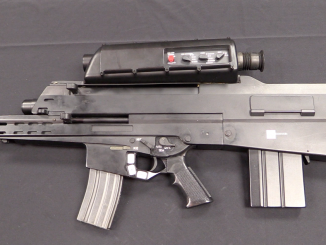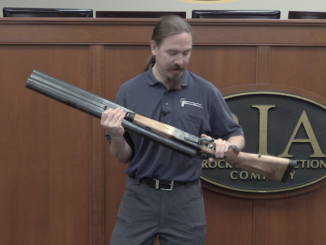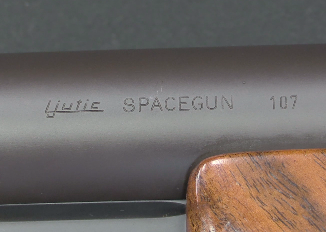This Thompson is being sold at Morphys on October 30, 2018.
The USMC had acquired a few hundred early 1921 model Thompson submachine guns in 1926, and prompted the US Navy to formally test the guns. The Navy requested a reduction in the rate of fire, in order to improve controllability and reduce ammunition consumption (20 round magazines go quickly at 900rpm!). Auto-Ordnance happily complied, and Oscar Payne returned to the company on his spare time to modify the gun. He did this my adding a substantial amount of mass to the actuator, and was able to reduce the rate of fire substantially. The Navy subsequently ordered 500 guns, designated the Model of 1928.
Since most of the original 15,000 guns made by Colt were still in inventory, Auto-Ordnance simply overstamped the “1” at the end of “1921” with an “8” and put the new heavier bolt assemblies in the guns, leading to the collector term “21/28 overstamp” for these Thompsons. The lower rate of fire would become the new standard for the Thompson.
By late 1928, only about 6,000 Thompsons had been sold, and by the end of 1938 10,300 had been sold. Of these, about 1500 total had gone to the US government, about 4100 exported, and the remainder to American police and security agencies. Times were not good for the Thompson – it was an expensive military weapon without a war that needed it. Despite the gun’s huge notoriety, it was actually not used in particularly large numbers by the motor bandits of the 20s and 30s, nor in great numbers by the police. While the FBI did purchase Thompsons, they only bought 115 in total, and not until 1935.
This is the second part in a 5-part series on the development of the Thompson…




I must admit it is funny that the Thomspon was, in fact, more of a “Bankster’s gun” than a “Gangster’s gun” – but Gangsters were sexier or something!
You can say ‘gangsters’ of different kind; more polite perhaps 🙂
Probably the final ‘extended’ customer for Tommy gun was one of famous Cuban revolutionaries….. historical ironies do not have ends.
https://en.wikipedia.org/wiki/Camilo_Cienfuegos
Surely, Thompson is sub-machine gun which has greatest number of associated myths, including for example “favorite weapon of George Kelly Barnes” implied by
https://en.wikipedia.org/wiki/Machine-Gun_Kelly_(film)
Most hilarious movie I recall which featured Tommy gun was this
https://www.youtube.com/watch?v=rI_lUHOCcbc
Two “ladies” were witnesses of gang shootout which spelled trouble for them winding thru entire movie. At the opening scene one gang dispatched competitor one during fake birthday celebration. Shooter with T-gun from first team, disguised inside of enormous ‘cake’ suddenly broke cover and opened massive fusillade up close.
Here is the “cake” scene https://www.youtube.com/watch?v=iy0zNDfVZOQ
There was actually one before in Chicago… my failing memory 🙂
Thompson sub-machine gun fame was so great, that it even appeared in combloc’s gangster film comedy: http://www.imfdb.org/wiki/D%C3%A9j%C3%A0_Vu_(1988)
(not to be confused with U.S. film under same title)
I forgot to add: before you see mentioned film: DISCLAIMER: you might not understand all jokes without some knowledge of History of Soviet Union/1920s, for example at one time one gangster is saying about new era of moonshine which is pun intended against NEP: https://en.wikipedia.org/wiki/New_Economic_Policy
There were the Irish rebels:
https://www.historyireland.com/20th-century-contemporary-history/the-tommy-gun-the-irish-connection/
I think June 1921 marks Irish use as the first–and even though for a while it was just two guns, they had a lot of use.
“Gangster Gun”: 1930’s media hype-word used to promote political action. See “Saturday Night Special” in the late ’60s and “Assault Weapon” in the ’90s.
To state my view of those straw-stuffed politicians, I must quote a videogame mob enforcer. “You guys are a joke, and here’s the punchline!!” The pen isn’t mightier than the sword if the pen only exists to “control the minds of law-abiding people.” The sword is only the extension of the one who wields it. The same is said of the gun.
Citing Adrian Carton de Wiart:
Governments may think and say as they like, but force cannot be eliminated, and it is the only real and unanswerable power. We are told that the pen is mightier than the sword, but I know which of these weapons I would choose.
Which is undoubtedly confirmed by his service record. I would not write it here in whole as it would be really long, but I will just say that he was awarded Distinguished Service Order during Great War [which was awarded for action under enemy fire].
“More of a banksters gun” demonstrates an axiom of guerrilla warfare–one guerrilla ties down ten regular soldiers. Without verifiable numbers I can only speculate, but perhaps the movie industry bought more Thompsons than the Dillinger Gang. Police Thompsons outnumbered criminal Thompsons–and police armories were a major source of tommy guns for the underworld–just like guerrillas used to get most of their firearms from domestic police and military armories. Since at least World War Two there have been foreign governments willing and able to supply guns by the ton to any proxy warriors worldwide.
My linking criminal gangs and guerrillas isn’t mere whim. During the Twenties and Thirties, “organized crime” and the “underworld” were feared as competitors to the federal government–Al Capone was taken down more because he was a threat to the political system as a rival to “honest” politicians than because Capone was violating the Volstead Act and murdering other underworld figures.
With the lock piece leaning under quite pronounced angle back (my guess is around 45deg)it suggests that the resistance to blowback is not really that big. I’d wish to know a bit more about initial experimentation which lead to this particular lock angle. One would think, if angle is less acute, the resistance would grow and thus RoF will be lower.
This is one subject to consider; another directly connected one is mass of bolt (as increased by mentioned modification and even more). I had Thompson in my hand once and one of things drawing my attention was that surprisingly light hollow bolt. In hindsight, the simplest thing how to arrive more favorable result would be to drop out the lock and increase bolt weight which was the final step in development of this peculiar weapon.
One thing that seems odd is that the weight attached to the actuator has lightening cuts on its sides.
Yes, good observation. Perhaps without the cuts it would go 550RPM which is not what customer wished for. Guns have mind of their own 🙂
You are probably right. It just has a trial and error prototype look about it.
I want to point some similarities between history of BAR and history of Thompson sub-machine gun, both were answers to trench warfare requirements
BAR
1. Originally created as automatic rifle (to be operated by 1 soldier)
2. Later development in direction of turning it into light machine gun
3. Result: weapon inferior in role of LMG to “full-blood” weapons of this type (like for example Bren)
Thompson
1. Though not strictly machine pistol in original form (“Annihilator”) as it was not full-auto/selective-fire variant of self-loading pistol, it is somewhat in-between pure machine pistol and MP18-like sub-machine gun
2. Later development in direction of making it more MP18-ish (wooden stock, drum magazine)
3. Result: weapon heavier than already heavy sub-machine guns of 1920s-1930s
It is interesting that in both cases Europeans in point 2. made step further, namely for BAR: Kg m/37: http://modernfirearms.net/en/machineguns/sweden-machineguns/kg-m21-m37-eng/ which featured quick-change barrel
for Thompson: BSA Model 1926 Thompson: https://www.forgottenweapons.com/bsa-1926-1929-thompson-smgs/
BAR as LMG: both the FN Mle D and the last version by Colt (R75A) featured a quick change barrel as well. The FN D was probably the best BAR for LMG use, limited only by the 20 round magazine. However, smallish magazines for LMGs were not out of the ordinary at the time: the French FM 24/29 had a 25 round magazine and the Finnish Lahti-Saloranta M/26 a 20 round magazine.
“smallish magazines for LMGs were not out of the ordinary at the time: the French FM 24/29 had a 25 round magazine and the Finnish Lahti-Saloranta M/26 a 20 round magazine.”
After some thinking I must agree that small magazines were quite popular in 1930s designs of LMG, beyond mentioned models it can be also found in:
Breda Modello 1930 (20 rounds)
MG 13 (25 rounds; also available 75 rounds-magazine for AA aplications), inter-war German (13 is fake designation to make it appear as 1913 design) machine gun, overshadowed by later German development (MG 34) but still in use during WW2
ZB vz. 26 alias MG 26(t) (20 rounds)
Mendoza C-1934 (20 rounds)
SIG KE-7 (25 rounds) Swiss-made machine gun only for export markets
Knorr-Bremse MG.35/36 (25 rounds) machine gun in limited use by Waffen SS; accept MG 13 magazines
In 1932 my home town in South East New Mexico was visited by Bonnie and Clyde. They were visiting relatives. A deputy saw some guns in the back of their car, and knocked on the door of the house they were in. Long story short, they kidnapped the deputy and drove out of town, letting him go, unharmed, near San Antonio Texas.
The aftermath was that the city police department thought, what with bandits visiting and all, that they were under gunned so they bought one Thompson. Never to be fired in anger as far as I know. It is in the local museum now. And the deputy later became Sheriff and eventually the police chief.
Here’s a tale by one the readers of this web site, Bill Bullock, about his use of a Thompson in Wildsville, Louisiana:
Mr. Jones and Mr. Bullock: Two Americans stand up to a bunch of domestic terrorists, U.S.A. 1966
http://twoalpha.blogspot.com/2014/12/mr-jones-and-mr-bullock-two-americans_24.html
Too bad the descendants of that generation of people of color are now losing their right to vote to a new wave of legal trickery just like the original one in the 1870s. The KKK was not beaten by their victims shooting back, but by the Federal Government temporarily being the product of the weight of their votes after Congress passed laws (now being overturned) singling out right-wing states for that trickery. As of this week, a Native American in North Dakota living on a reservation has no right to vote because, dig it, he only has a Post Office #.
Just wait until the state governor gets rocks, fire-bombs, and lots of bullets coming at his house. Laws that disenfranchise voters just because they don’t have mailboxes tend to fail in one way or another. Either the state can offer the Natives free mailboxes or the law must be repealed. Whether the latter option requires picket signs or a hail of copper-jacketed lead isn’t my problem but the issue can’t be ignored forever!
Your fibre buffer washer is in the wrong place..
When I was at MCRD San Diego during the summer of 1975, part of History and Traditions was the story of the Marine Corps guarding the US Mail–and the tommy gun.
https://marines.togetherweserved.com/usmc/newsletter/38/Marines%20Guard%20the%20US%20Mail%201921.html
Two different deployments, one in 1921 (no Thompsons, just rifles and pistols and shotguns) and one in 1926 (the Postmaster General purchased some 200 Thompson Model 1921 submachine guns and “loaned” them to the Marines).
https://www.wearethemighty.com/history/intense-rules-for-marine-guards
When the Marines left the US Mail service, the Thompsons went with them.
My take as a scared young Marine recruit was that the Marines STOLE postal service machine guns and their next stop was the Banana Wars.
Thompson’s gun was the poster child of federal gun control in 1934–and that failed strategy has led to “ineffective gun control” for some 85 years. Today, it’s that “ugly” and “unusual” black rifle, the AR-15–and gun control pundits keep repeating the past.
As crime statistics before 1934 essentially didn’t exist (the FBI began collecting them in 1930 and it took a few years to get the bugs out of their collection system) there’s little proof of a massive crime wave during the Roaring Twenties other than newspaper, news reel and motion picture fantasies. That didn’t stop the New Deal Attorney General with the improbable name of Homer Stille Cummings from sponsoring what became the National Firearms Act of 1934.
https://www.recoilweb.com/origins-of-the-nfa-128767.html
At first, the NFA was going to mandate that all handgun owners be licensed and that all handguns be federally registered–with annual renewal and fees and taxes. The National Rifle Association and the United States Revolver Association were fully on-board, having written the model legislation designed to reduce the number of revolvers and automatics in “the wrong hands”–until there was a falling out over the fees schedule and NRA/USRA participation in this national licensing and registration scheme. The National Firearms Act was intended to eliminate pistols and revolvers–but failed because AG Cummings didn’t seize the national licensing and registration and keep the NRA/USRA as allies–he alienated them. Had the pistol ban went into law, even at a paltry $5 per pistol, the precedent would have been set and increasingly draconian measures could have been added later. The shadows of the pistol ban are the bans on handgun substitutes–sawed off shotguns and short barrel rifles. The Tommy gun was central to passage of NFA 1934 because Thompson’s portable pistol-caliber machine gun was sexy and got headlines. Without the Tommy gun and with Prohibition’s abject failure a recent event, there may have been no National Firearms Act.
By the way, like the AR-15, American (and British) military establishments didn’t want the Thompson. Yes, there were the Marines–who fought “real wars” guarding the US Mail and in the Banana Wars and in China during the Roaring Twenties and the Great Depression. It took a world war for America and Britain to recognize that portable automatic weapons were a staple in modern war. The Model of 1921 Thompson Submachine Gun was not a “weapon of war” when the National Firearms Act was passed, just like the AR-15 wasn’t a battlefield weapon when the Assault Weapon Ban of 1994 became law, expired due to a sunset clause, or today. Besides, the issue was eliminating “killing weapons” that could fire more than one shot without reloading, that were portable and concealable, and that could be used by crime victims to disrupt political activists such as the Ku Klux Klan, which was a significant political power during the Roaring Twenties.
Things don’t seem to have changed in 85 years. Still lying about gun “control” and using the scarecrow of “battlefield weapons” like the Thompson or the AR-15. No wonder gun control failed!
About the tax stamp for a Thompson submachine gun–it’s a bargain at the original $200 level established in 1934. There’s the months-long wait, having to get local law enforcement approval, and a stringent background check, but inflation has turned $200 dollars from 1934 into $3,814 dollars in 2019. The original proposal included a licensing fee paid annually by the owner and the registration tax stamp was to be renewed annually as well, just like car registration. “Failure to play nice with others” and share political power led to the NFA tax stamp being frozen in time at the 1934 level.
Thank you, Attorney General Homer Stille Cummings! If you had played fair, shared power with others, $3,814 per year per pistol would have been just the beginning. Originally magazine capacity would have been 12 cartridges under the National Firearms Act. There was a license fee as well–and may have required membership in either the National Rifle Association or the United States Revolver Association (or both) as well as local jurisdiction licensing and registration fees. The power to tax is the power to destroy.
So while the seller of the few Thompsons in the national firearms registry wants to recoup 85 years of machine gun taxes paid, that $200 tax stamp is a bargain compared to what it could have been.